Black Ash assessment guidelines
How to conduct a health assessment of Black Ash (Fraxinus nigra) for the purposes of the Endangered Species Act, 2007 (ESA).
1. Purpose
These guidelines provide information about how a health assessment of Black Ash (Fraxinus nigra) should be conducted for the purposes of the Endangered Species Act, 2007 (ESA) and specifically pursuant to O. Reg. 6/24 (Limitations on Section 9 Prohibitions).
These guidelines should be read in conjunction with the ESA and regulations under the Act.
The methods described in these guidelines may be subject to change as new information becomes available.
2. Overview
2.1 Species status
Black Ash is listed as endangered on the Species at Risk in Ontario List (SARO List) in O. Reg. 230/08. While Black Ash is a widespread tree species that can be found throughout much of Ontario, many trees are affected by the invasive Emerald Ash Borer (Agrilus planipennis), a wood-boring beetle that feeds on trees of all ash species in Canada. The endangered status of Black Ash is based on observed and predicted declines due to Emerald Ash Borer (EAB).
The recovery strategy required under the ESA for Black Ash was published on September 6, 2022, and provides the best available scientific knowledge on what is required to achieve recovery of the species. The species-specific policy for Black Ash, known as the Government Response Statement (GRS), was published on January 25, 2024, and includes the government’s recovery goal for the species and the actions and priorities it intends to lead or support to help achieve that goal. The GRS was developed by considering the science advice provided in the recovery strategy, as well as taking into account social, cultural and economic factors.
2.2 Relevant legislation
Black Ash is classified as an endangered species on the SARO List, and therefore it and its habitat are protected under the ESA. Section 9 of the ESA includes prohibitions against killing, harming, harassing, capturing or taking of Black Ash. Section 10 of the ESA includes prohibitions against damage or destruction of Black Ash habitat.
O. Reg. 6/24 limits the application of the prohibitions in section 9 of the ESA to certain circumstances for Black Ash and O. Reg. 832/21 defines what is considered Black Ash habitat under the ESA.
2.2.1 Species protection
Per O. Reg. 6/24, the prohibitions in clause 9(1)(a) of the ESA (against killing, harming, harassing, capturing or taking) apply to any living Black Ash tree with a diameter at breast height (DBH)
The qualified professional’s report must include the information set out in the regulation (see section 2(3) of O. Reg. 6/24 and section 4.1 (Report contents) of this document) and the report must be submitted to the Ministry of the Environment, Conservation and Parks (hereafter the Ministry) at SARontario@ontario.ca prior to commencing any activity that may impact the Black Ash.
The prohibitions in clauses 9(1)(b) and (c) of the ESA (i.e., possession, transportation, buying, selling, or offering to buy or sell, etc.) do not apply with respect to Black Ash anywhere in Ontario.
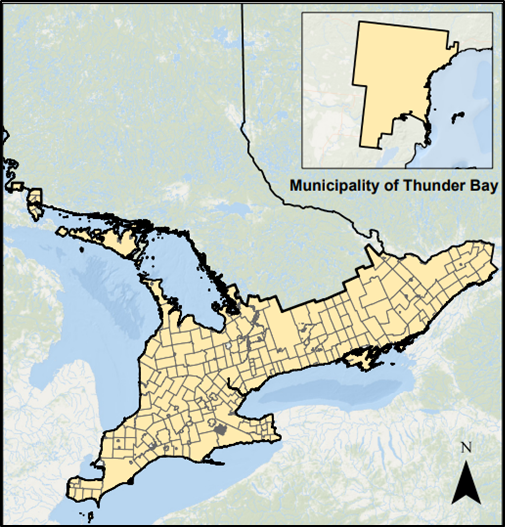
Figure 1. Geographic scope of regulatory approach for Black Ash. Prohibitions in clause 9(1)(a) and 10(1) do not apply outside of the yellow-shaded area. Please refer to Schedule 1 of O. Reg. 6/24 for the complete list of municipalities and territorial districts.
| Tree size | Living tree located in a municipality or territorial district identified in Schedule 1 of O. Reg. 6/24 | Living tree located in a municipality or territorial district not identified in Schedule 1 of O. Reg. 6/24 | Dead tree located anywhere in Ontario |
|---|---|---|---|
| DBH ≥ 8 cm (measured at 1.37 m) | Prohibitions apply unless the tree is identified as “unhealthy” in a report prepared and submitted by a qualified professional in accordance with the regulation | Prohibitions do not apply | Prohibitions do not apply |
| DBH < 8 cm or tree <1.37 m | Prohibitions do not apply | Prohibitions do not apply | Prohibitions do not apply |
2.2.2 Habitat protection
Per O. Reg. 832/21, Black Ash habitat is defined as the areas within a radial distance of 30 m around each Black Ash tree to which the prohibitions in clause 9(1)(a) of the ESA apply (in accordance with O. Reg. 6/24). The prohibitions in subsection 10(1) of the ESA (against damage and destruction) apply to these areas. This protects and maintains essential habitat conditions (the critical root zone) around each healthy tree.
For additional guidance on whether a proposed activity is likely to damage or destroy habitat protected under subsection 10(1) of the ESA, please review the policy on Categorizing and Protecting Habitat under the Endangered Species Act.
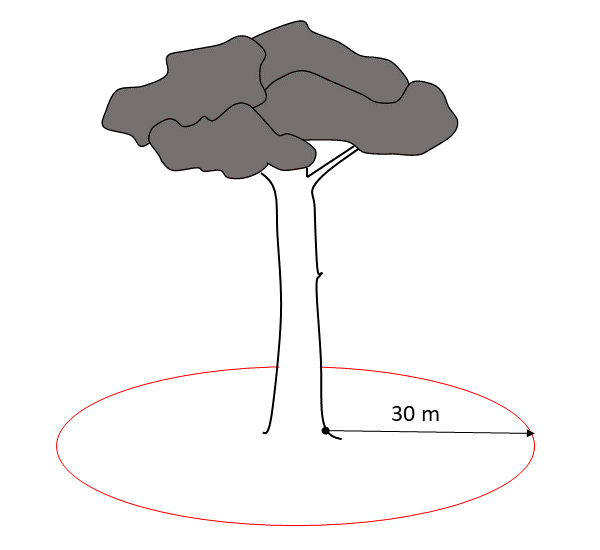
Figure 2. Radial distance of 30 metres around the stem of a protected Black Ash tree that represents the tree’s habitat as described in O. Reg. 832/21.
3. Determining if ESA prohibitions 9(1)(a) apply to a Black Ash tree
Prior to beginning an assessment, refer to Schedule 1 of O. Reg. 6/24 to determine whether ESA prohibitions for Black Ash in clause 9(1)(a) apply in the municipality or territorial district where each tree that may be impacted by the activity is located. A health assessment is not required for a tree if the tree is in an area not listed in Schedule 1.
3.1 Measuring diameter at breast height (DBH)
Prior to conducting the health assessment, an initial measurement of tree size can be taken to determine if the prohibitions under the ESA apply to the tree. A qualified professional is not required for this initial measurement of tree size. However, if a health assessment is undertaken, a qualified professional will need to take measurements for the purpose of that assessment, as per section 3.2 of this guide.
To determine the tree size, the following steps should be completed:
1. Measure up 1.37 m from the base of the tree along the stem (Figure 3i). If the tree is on an incline, measure vertically from the base of the tree at the highest part of the slope (Figure 3ii). If the tree is leaning, the height of 1.37 m should be measured parallel to the leaning stem, and DBH should be measured perpendicular to stem (Figure 3iii).
If the tree has a single stem, or if it divides into multiple stems and the point where the tree divides into multiple stems is above 1.37 m from the base of the tree (e.g., Figure 3iv), proceed to step 2a.
If a tree divides into multiple stems and the division is below 1.37 m, proceed to step 2b (Figures 3v and vi).
If the tree is less than 1.37 m tall, ESA prohibitions 9(1)(a) do not apply and a health assessment is not required for that tree. However, a count of the number of trees less than 1.37 m tall is required if submitting a report to the Ministry for other trees in the area impacted by the same activity.
2. Mark the point at which tree size is to be measured using the appropriate method as determined in step 1:
- Mark the point at 1.37 m from the base of the tree. Proceed to step 3.
Or,
- Mark the point of the stem with the greatest diameter at 1.37 m from the base of the tree (Figure 3v). If the stem with the greatest diameter cannot be determined visually, mark each of the stems at 1.37 m (Figure 3vi). Proceed to step 3.
3. If measuring with a regular soft measuring tape:
- Measure the circumference of the stem(s) at the marked point(s).
- Record the measurement(s) in centimetres to a single decimal point (for example, a circumference of 12 cm and 3 mm would be measured as 12.3 cm).
- Divide the recorded measurement(s) by 3.14.
If measuring with diameter tape or tree calipers, record resulting diameter measurement in centimetres to a single decimal point
4. If a single stem measurement was taken, the resulting value is the tree’s diameter at breast height (DBH).
If multiple stem measurements were taken, the greatest single resulting value is the tree’s DBH.
If the DBH is 8 cm or greater, ESA prohibitions 9(1)(a) apply to the tree unless a report identifying the tree to be unhealthy is prepared by a qualified professional and submitted to the Ministry.
If the DBH is less than 8 cm, ESA prohibitions 9(1)(a) do not apply to the tree and a health assessment is not required. However, under O. Reg. 6/24, a count of the number of trees less than 8 cm DBH is required if submitting a report to the Ministry for other trees in the area impacted by the same activity.
Figure 3. Measuring DBH under different scenarios described in section 3.1
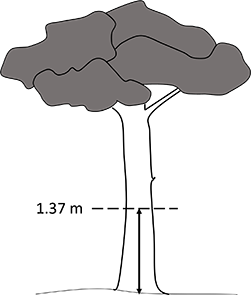
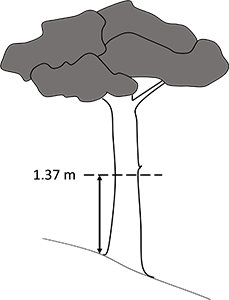
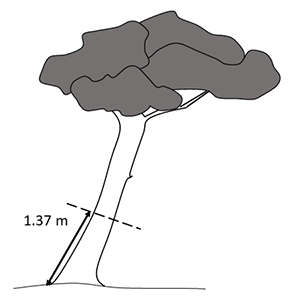
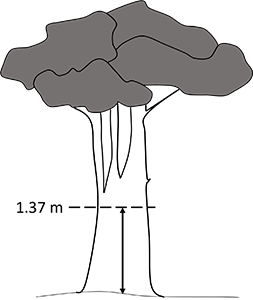
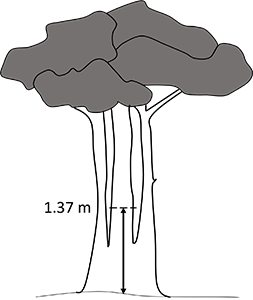
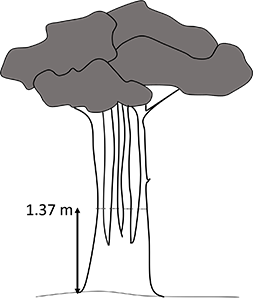
3.2 Black Ash health assessment
The ESA prohibitions in clause 9(1)(a) do not apply to a Black Ash tree with a DBH of 8 cm or greater if a health assessment report prepared by a qualified professional identifies the tree as “unhealthy” and is submitted to the Ministry. The report must meet the requirements set out in regulation.
Determining the health condition of a Black Ash tree is the main objective of a health assessment and will be based primarily on the tree’s canopy condition and visually identifiable factors that are indicators of tree health. The health assessment must be conducted by a qualified professional. Methods and considerations for making this determination are provided in the following sections.
3.2.1 Timing of assessments
A complete health assessment of a Black Ash tree should generally be conducted during the “leaf-on” season. Leaf-on season begins with the flushing of leaves in the spring and ends with leaf yellowing and leaf fall. Exact dates vary depending on the geographic location of the tree and seasonal variability from year to year. For the purposes of this guide, an assessment will be considered to have been conducted during the leaf-on season if it was conducted between the dates of June 1 and October 1.
In some circumstances, it may be possible to determine that a Black Ash tree is dead or very unhealthy from bark condition indicators on branches outside of leaf-on period. A qualified professional may assess a tree outside of the leaf-on period if they are confidently able to determine the tree’s health status, including considering the condition of the tree’s canopy and the extent of any dieback or regeneration of that canopy, at the time of the assessment.
Black Ash health assessments should be conducted as close as possible to the date of an activity that may impact the Black Ash tree or its habitat. This is because the extent to which the trees are affected by Emerald Ash Borer or other stressors may change between the date of the assessment and the activity date, and because Black Ash saplings may have increased in height or DBH since the date of the assessment.
3.2.2 Assessing canopy condition
The tree’s canopy should be examined for signs of thinning, defoliation and dieback, observing it from multiple angles. Only sun-exposed branches should be evaluated, as natural thinning or defoliation may occur on shaded branches.
In some cases, Black Ash may regenerate a lost canopy from vegetative shoots and/or new leaves in the crown of the tree. In these cases, the suspected cause of the canopy loss (e.g., Emerald Ash Borer, drought, storm damage) and the condition of regenerated canopy should be taken into account during a health assessment.
The qualified professional should assign a rating to the tree’s canopy using the five-point canopy condition rating system in Table 2.
| Rating | Description |
|---|---|
| 1 | Canopy is full and healthy |
| 2 | Canopy has started to lose leaves (thinning), but no dieback (dead top canopy twigs without leaves) is present |
| 3 | Canopy has less than or equal to 50% dieback |
| 4 | Canopy has more than 50% dieback |
| 5 | Canopy has no leaves; epicormic or basal shoots may be present on the trunk |
3.2.3 Assessing Emerald Ash Borer infestation
The presence and severity of Emerald Ash Borer infestation should be assessed based on direct observation of Emerald Ash Borer in its adult or larval life stage, Emerald Ash Borer exit holes (D-shaped openings, usually seen late in the infestation process), and larval galleries (serpentine galleries seen beneath the bark) (Figures 4 and 5). These signs should be assessed by visual surveys (for example, see de Groot et al. [2006]).
If past or current infestation is identified, the severity should be classified into one of the following categories based on the presence of one or more of the signs listed below:
- Low severity
- minimal or no Emerald Ash Borer exit holes observed on the bark
- minimal or no evidence of larval galleries beneath the outer bark
- minimal or no observations of Emerald Ash Borer adults or larvae
- Medium severity
- evidence of several exit holes observed on the bark, especially on the lower stem
- evidence of several larval galleries beneath the outer bark, which may be linked to bark splitting or cracking
- some direct observation of multiple Emerald Ash borer adults or larvae
- High severity
- numerous exit holes observed on the bark, including higher up the stem or on major branches
- evidence of extensive larval galleries beneath the outer bark, which may be linked to extensive bark damage
- abundant Emerald Ash Borer adults or larvae
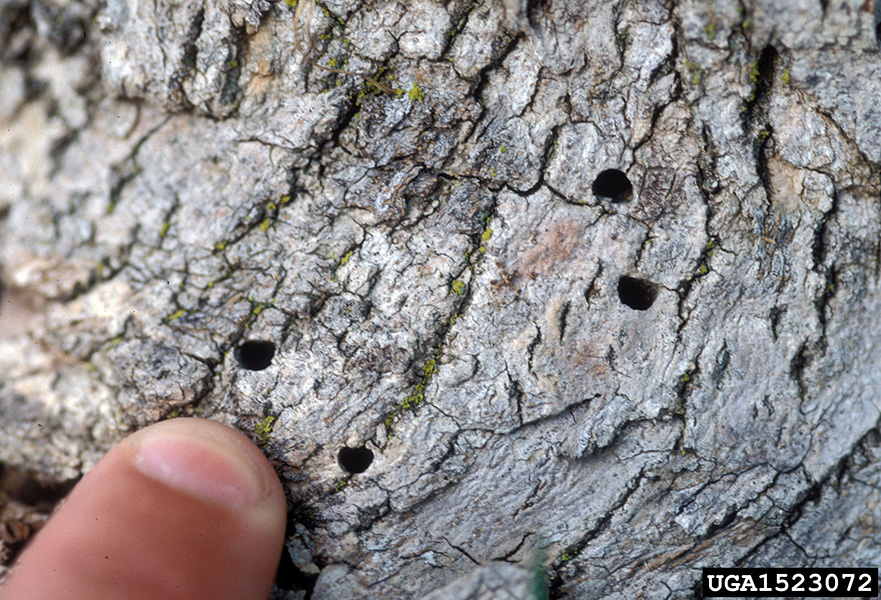
Photo credit: Daniel Herms, The Ohio State University, Bugwood.org CC BY 3.0 Deed
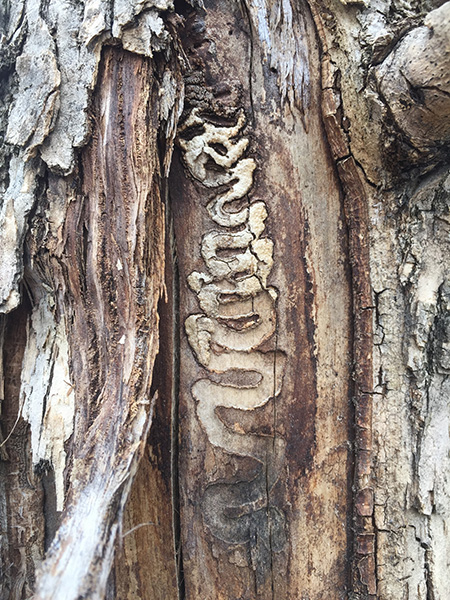
Photo credit: judygva / CC BY 2.0 Deed
3.2.4 Assessing other possible health stressors
Any factors other than Emerald Ash Borer that may be contributing to the condition of the tree, such as pathogens or pests, competition, poor habitat quality, low relative crown class (see Table 3), drought conditions, effects of wind exposure, injuries and site degradation (e.g., soil compaction) caused by human activities, should be assessed.
| Category | Description |
|---|---|
| Dominant | Above general canopy of stand; receives direct sunlight on top and all sides |
| Codominant | Average position in stand; receives direct sunlight on top and at least one side |
| Intermediate | Below general canopy; receives direct sunlight on top |
| Suppressed | Completely overtopped; receives no direct sunlight |
If the presence of past or current factors that may be contributing to the tree’s observed health condition are identified, the severity of the impact of those factors should be classified into one of the following categories:
- Low severity
- minimal to no observable impact on tree health
- Medium severity
- moderate impact on tree health, resulting in observable signs of stress
- High severity
- significant impact on tree health, resulting in widespread signs of stress
3.2.5 Health determination
Based on the findings during the assessment, the qualified professional must make a determination as to whether a tree is significantly declining or exhibiting the effects of a significant decline in health. Generally, a tree that is reasonably expected to die within a five-year period of the assessment would be considered unhealthy.
The following criteria should be used as a guide:
Canopy condition rating of 1 or 2: the tree should be considered healthy.
Canopy condition rating of 3: the tree should generally be considered healthy if the severity of stressors, including Emerald Ash Borer infestation, is such that mortality is unlikely within a five-year period. The tree should generally be considered unhealthy if mortality is expected within a five-year period. In making this determination, assessors should consider the tree’s canopy condition, the severity of impact of stressors, and the tree’s canopy condition and stressors relative to other trees being assessed. For example, a tree exhibiting below average dieback and/or higher canopy regeneration compared to other trees in the activity location experiencing equal or lesser stressors may be showing a positive health response, indicative of lower mortality risk.
Canopy condition rating of 4 or 5: unless there is evidence to suggest the tree may survive longer than 5 years (e.g., evidence of resistance to EAB), the tree should be considered unhealthy.
A report does not need to be submitted to the Ministry if all trees assessed are determined to be healthy. An ESA authorization or registration for an applicable conditional exemption would be required if impacts to healthy trees or their habitat cannot be avoided.
If at least one tree is considered unhealthy, a completed report must be submitted to the Ministry in accordance with the regulation for the prohibitions in section 9(1)(a) to not apply to the unhealthy trees. In order for the report to meet the requirements of the regulation, all trees that may be impacted by the activity and meeting the size threshold (DBH of 8 cm or greater) must be assessed and included in the report submitted to the Ministry. A count of trees that may be impacted by the activity but do not meet the size threshold must also be included.
If an activity will impact both healthy and unhealthy Black Ash trees, an ESA authorization or registration for an applicable conditional exemption will be required unless impacts to healthy trees or their habitat can be avoided.
4. Black Ash health assessment reports
If the qualified professional determines a tree to be unhealthy, ESA prohibitions in clause 9(1)(a) do not apply to the tree, provided a report completed by the qualified professional who conducted the assessment is submitted to the Ministry before the activity is undertaken. The report must include assessment results for all healthy or unhealthy trees that would be subject to impacts by the same activity, as well as:
- A description of the qualifications of the qualified professional who prepared the report, including any supporting documentation.
- The date the qualified professional conducted the assessment of each tree subject to the report.
- A description of the activity, including if the activity is a part of a larger activity, such as a development, construction, resource, utility, transportation or landscaping project.
- The number of Black Ash with a stem less than 1.37 m high or a DBH less than 8 cm that may be impacted by the activity.
- The number of and location of each Black Ash with a DBH of 8 cm or greater that may be impacted by the activity, including the geographic coordinates of each of the Black Ash.
- For every Black Ash with a DBH of 8 cm or greater that may be impacted by the activity, the following information:
- The diameter of the stem of the tree measured at a height of 1.37 metres.
- A description of whether the tree is or has been infested by Emerald Ash Borer, and the severity of any infestation.
- A description of any factors other than Emerald Ash Borer that may be contributing to the condition of the tree, such as disease, competition and environmental conditions, and the severity of the impact of those factors on the tree.
- A statement that indicates a determination, based on the factors set out in ii and iii above, of whether the tree is healthy or unhealthy.
- A detailed description of the evidence supporting the tree’s health determination.
- Supporting documentation for each tree that includes photographic evidence.
In completing the descriptions referred to above, the qualified professional shall consider the condition of the tree’s canopy and the extent of any dieback or regeneration of that canopy.
A worksheet to facilitate reporting is available as an appendix. Qualified professionals should use the most up to date version as this worksheet may be amended from time to time.
Submit the report to SARontario@ontario.ca prior to starting your activity in order to avoid contravening the ESA.
5. References
5.1 Legal
- Endangered Species Act, 2007, Statues of Ontario 2007, c. 6
- O. Reg. 230/08 (Species at risk in Ontario list)
- O. Reg. 6/24 (Limitations on section 9 prohibitions)
- O. Reg. 832/21 (Habitat)
5.2 Technical
De Groot, P., W.D. Biggs, D.B. Lyons, T.A. Scarr, E.J. Czerwinski, H.J. Evans, W.A. Ingram and K. Marchant. 2006. A visual guide to detecting Emerald Ash Borer damage. Natural Resources Canada, Great Lakes Forestry Centre, Sault Ste. Marie, Ontario, Ontario Ministry of Natural Resources.
Knight, K.S., Long, R., and Daniel Yaussy. 2008. How fast will the trees die?: Modeling ash (Fraxinus spp.) decline in forest stands infested by emerald ash borer (Agrilus planipennis). In Proceedings of the Emerald Ash Borer Research and Technology Development Meeting, Pittsburgh, Pennsylvania. 23-24 October 2007. Edited by V. Mastro, R. Reardon, and G. Parra. U.S. Department of Agriculture, Forest Service, Forest Health Technology Enterprise Team. pp. 28-29.
Knight, K.S., B.P. Flash, R.H. Kappler, J.A. Throckmorton, B. Grafton and C.E. Flower. 2014. Monitoring ash (Fraxinus Spp.) decline and Emerald Ash Borer (Agrilus planipennis) symptoms in infested areas. United States Department of Agriculture, Forest Service, Northern Research Station.
Oliver, C.D and B.C. Larson. 1996. Forest stand dynamics: update edition. New York: John Wiley and Sons.
6. Appendix: Worksheet example
This worksheet is an example of how to meet the reporting requirements described in O. Reg. 6/24. The report and supporting documentation (e.g., photographs) must be submitted to SARontario@ontario.ca prior to undertaking any activity.
A printable template is available in the PDF version of these guidelines (page 20).
Black Ash Health Assessment Report Worksheet (Example)
To meet requirements of O. Reg. 6/24, a report must be submitted to the Ministry of the Environment, Conservation and Parks at SARontario@ontario.ca prior to undertaking an activity that will harm, harass, kill, capture or take unhealthy Black Ash with DBH 8 cm in the areas of the province where Endangered Species Act, 2007 prohibitions 9(1)(a) apply.
| Name of qualified professional preparing the report | Forrest Greene |
|---|---|
Description of qualifications of qualified professional Supporting documentation attached [ x ] | RFP with 6 years experience assessing ash tree health and Emerald Ash Borer |
| Description of the activity that may impact Black Ash, including if the activity is part of a larger activity (e.g., development) | Removal of trees to clear lot to construct residential building |
| Site name (if applicable) and address | 123 Conservation Rd., Sartown, Ontario |
| Assessment date(s) | August 1, 2024 to August 4, 2024 |
| Count of Black Ash less than 1.37 m in height and/or less than 8 cm DBH | 12 |
|---|---|
| Count of Black Ash with a Diameter at Breast Height (DBH) of 8 cm or greater | 6 |
| Number | Date of assessment (yyyy/mm/dd) | Geographic coordinates (e.g., UTM or lat/long) | Diameter at breast height (cm) | Canopy condition rating (1 to 5) | Signs of past or present EAB infestation (yes, no) | Severity of EAB infestation (low, medium, high, n/a) | Other factors contributing to condition of tree | Severity of other factors (low, medium, high, n/a) | Determination of health condition (healthy, unhealthy) | Detailed description of evidence of health status | File name(s)/ photo identifier(s) |
|---|---|---|---|---|---|---|---|---|---|---|---|
| 1 | 2024/08/01 | def, rst | 17.2 | 5 | yes | high | none | n/a | unhealthy | extensive canopy dieback, no canopy regeneration, signs of severe EAB infestation | AB147, AB148 |
| 2 | 2024/08/01 | ghi, uvw | 23 | 1 | no | n/a | none | n/a | healthy | no dieback, no signs of EAB infestation | AB155 |
| 3 | 2024/08/01 | abc, xyz | 13.1 | 4 | yes | medium | evidence of drought conditions | medium | unhealthy | moderate dieback/canopy loss, signs of EAB and evidence of drought on site, some epicormic growth | AB157, AB158, AB159 |
| 4 | 2024/08/01 | abc, xyz | 13.7 | 2 | Yes | low | none | n/a | healthy | some thinning of canopy, some EAB signs (3 exit holes) | AB160, AB161 |
| 5 | 2024/08/04 | abc, xyz | 9 | 4 | no | n/a | mechanical injury to stem | high | unhealthy | moderate dieback, no canopy regeneration, severe mechanical injury to stem | AC004, AC005 |
| 6 | 2024/08/04 | abc, xyz | 20.4 | 5 | yes | high | none | n/a | unhealthy | extensive canopy dieback, no canopy regeneration, signs of severe EAB infestation | AC006, AC007 |
Statement of health determination: By signing below, I attest to the health condition determinations that I have made as a qualified professional in this Black Ash Health Assessment Report.
Signature: Forrest Greene
Related
Footnotes
- footnote[1] Back to paragraph Note that forest operations undertaken on Crown land and in a forest management unit in accordance with the Crown Forest Sustainability Act, 1994, are exempt from certain provisions of the Endangered Species Act, 2007.
- footnote[2] Back to paragraph Measured at a stem height of 1.37 metres.
- footnote[3] Back to paragraph Based on Knight et al. (2008) indicating a healthy stand of ash trees can experience 98% mortality within six years once infested by EAB and 50% mortality in 4 years.